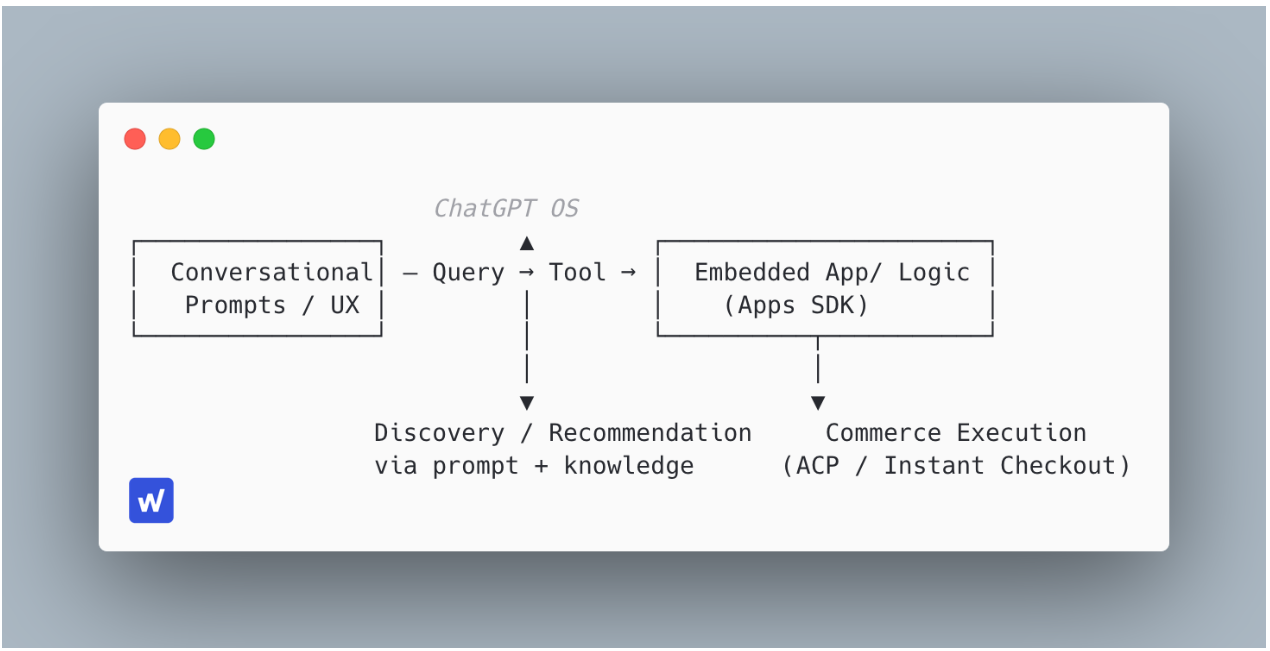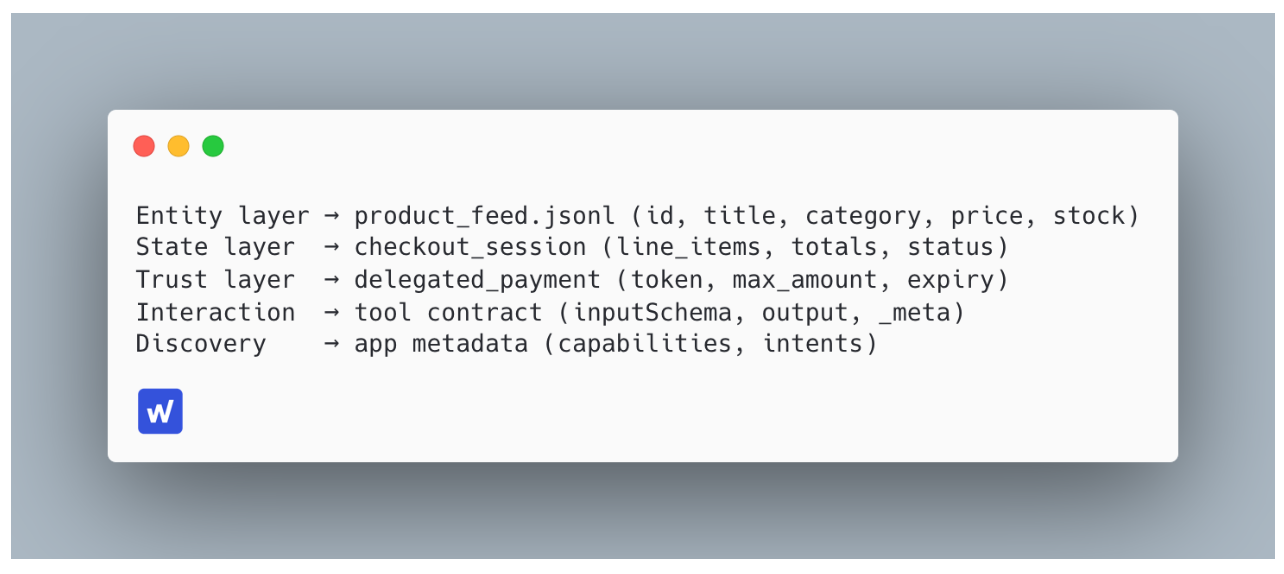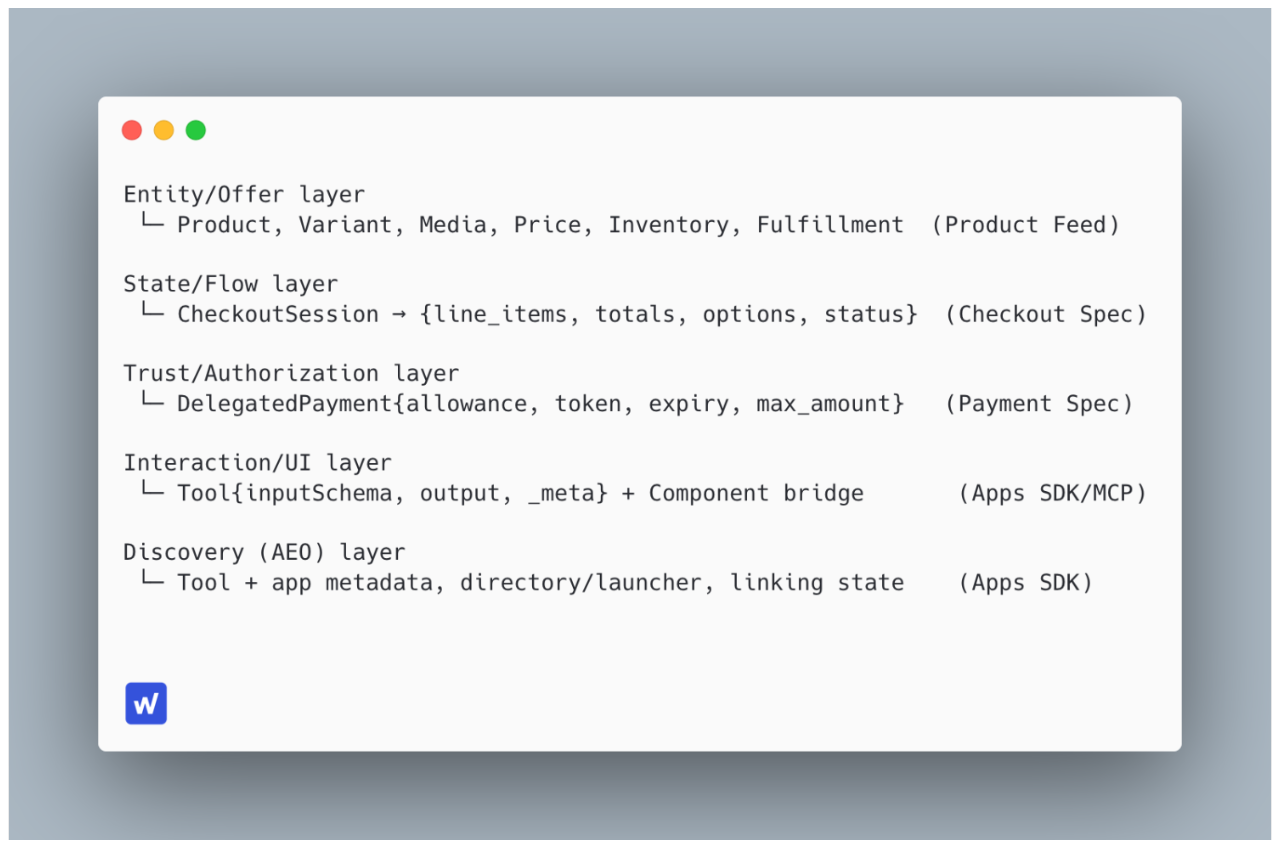Following the bulletins from OpenAI on October sixth, manufacturers begin to have actual methods to function inside ChatGPT. At a really high-level that is the map for anybody contemplating coming into (or increasing) into the ChatGPT ecosystem:

The ChatGPT Ecosystem
Conversational Prompts / UX: optimize how ChatGPT “asks” for or surfaces model providers. That is the realm of AEO / GEO. ChatGPT acts as a brand new floor for model discovery and advice. Relevance is determined by structured information, readability of worth, and conversational usability. Suppose: Manufacturers can promote conversational intents.
Embedded App / Logic (Apps SDK): combine your service so ChatGPT can name your backend/actions instantly contained in the chat. Lets customers chat instantly with built-in apps like Zillow, Canva, or Reserving inside ChatGPT. Suppose: Manufacturers can expose performance, not simply data.
Commerce Execution (ACP / Prompt Checkout): let customers full transactions through ChatGPT with out redirecting to exterior websites. ACP is an open customary (constructed with Stripe) that permits ChatGPT brokers to finish purchases instantly in-chat. Suppose: the AI can now “purchase” out of your model, securely and natively. No web site wanted.
The Agentic Net is rising and it’s about constructing for interactions contained in the AI and never solely about mentions and intent discovery. Win discoverability throughout all three layers and also you win website positioning 3.0.
The rising semantic layer: not simply new endpoints for manufacturers
Lily Ray’s publish known as out how OpenAI’s new specs lastly create an AEO floor distinct from website positioning. I agree however what’s much more fascinating is what’s beneath.
With the Apps SDK (constructed on high of the MCP) and the Agentic Commerce Protocol, we’re watching a semantic layer take form: a structured, interoperable approach for information, intent, and model logic to be learn and acted on by AI programs.
It’s now not merely about visibility or monitoring, it’s about legibility. In case your model’s information, affords, and logic aren’t outlined semantically, the AI can’t “use” you irrespective of how good your advertising is.
Beneath the floor, these specs outline a shared taxonomy for a way AI brokers interpret the world. Let’s evaluate it:


ChatGPT rising semantic taxonomy
Collectively, that’s the scaffolding of an AI-readable financial system, it is a system the place manufacturers aren’t listed, they’re invoked.
Most manufacturers are nonetheless optimizing floor content material. Most manufacturers are nonetheless determining in the event that they want Profound, OtterlyAI or Scrunch. The truth is that the true bottleneck is deeper: your information form. How legibly your catalog, logic, and achievement map into these schemas.
Till that’s solved, no quantity of immediate engineering makes you seen to AI brokers.


ChatGPT Semantic Layer / Taxonomy
What the specs really encode
1) Product/Supply ontology (discovery layer).
OpenAI’s Product Feed Spec standardizes what a “factor” is: IDs, GTIN/MPN, titles/descriptions, class path, model, media, worth, taxes, stock, variants (grouping + attributes), achievement, and service provider metadata together with flags that management whether or not objects are searchable vs purchasable in ChatGPT. That’s an express taxonomy for AI-legible discovery. Be taught extra about ChatGPT purchasing specification.
2) Checkout state machine (transaction layer).
The Agentic Checkout Spec requires retailers to reveal canonical endpoints (create/replace/full session) and to return a full, authoritative cart state on each response: line objects, totals, messages, achievement choices, standing enums, foreign money, hyperlinks, and so forth. It additionally defines headers (idempotency, signatures, API variations) and order webhooks – i.e., shared state and transitions the agent can cause over.
3) Fee delegation (belief/authorization layer).
The Delegated Fee Spec defines a one-time, constrained token (max quantity + expiry) issued by the PSP and tied to a checkout_session_id, plus structured error codes and danger alerts. It is a transportable authorization object the agent can go with out holding card information.
4) Device contracts + UI semantics (interplay layer).
In Apps SDK (on MCP), instruments should declare an inputSchema/output and required _meta fields (e.g., “openai/outputTemplate”), and gear outcomes are cut up into structuredContent (mannequin + part), content material (narration), and _meta (component-only). . This clearly separates reasoning information from rendering information.
5) Discovery/choice semantics (AEO floor).
Right here is the place issues get fascinating – apps are picked by the mannequin utilizing device metadata, prior utilization, context, and linking state; listing/launcher surfaces additionally depend on app-level metadata. That is the coverage floor the place “AEO” lives (the way you’re chosen), embracing website positioning 3.0.
Conclusion
The specs are public. The requirements are open. What’s lacking is your information mapped to them.
Earlier than investing in prompts, brokers, LLM trackers, or search instruments, repair the inspiration: product feed, state logic, and gear contracts.
→ Construct for the semantic layer — that’s the place the following wave of AI discoverability begins.
That’s how manufacturers turn into a part of the AI’s reasoning loop, not simply its search outcomes.



